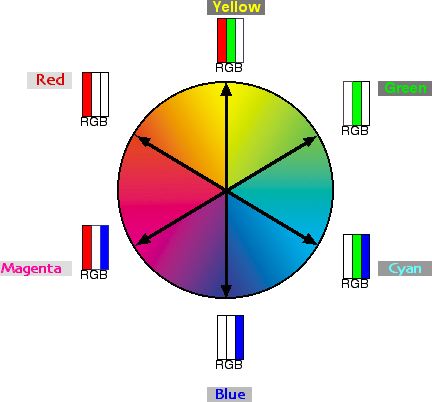

Red, green and blue are the primary colors of light. All other colors can be produced by mixing two or more of these colors in varying amounts and intensities. Remember: COLOR is a mental perception, based upon stimulation by light of particular wavelengths or frequencies. If there is no brain, there is no color, only light waves. What color do you think your blood is, while it is still inside your body where no light falls upon it?
Red + blue +green ( in equal amounts) = white.
Colors opposite (180 degrees) each other are complimentary. When combined, they produce white. Note the RGB color boxes. Color combinations that produce a full RGB box are complimentary.
Cyan, yellow and magenta are the secondary colors of light. Any secondary color mixed with it’s compliment produces white light. Note that our brain has the tendency to percieve an average of the wavelengths striking our eye. When equal amounts of both red and green enter our eye, the brain percieves yellow. The eye is more sensitive to reds and greens, and less sensitive to blues. This is why darker blue colors are more difficult for us to differentiate than darker shades of red. Something entirely different happens with our perception of violet. Violet color can be produced by mixing red and blue in the right proportions, but our brain still perceives violet at the shorter wavelength end of the spectrum when no red light at all is present.
In the RGB boxes, the colored bands are the colors which, when present in equal amounts, produce the labeled color while the “blank” bands are the light colors absorbed by an object that reflects the labeled color. For example: cyan is produced when equal amounts of blue and green are mixed, but a cyan object absrobs red. Also, a red transparent filter absorbs the “blank” band colors green and blue, permitting only red wavelengths to pass.
TRENDS APPARENT WITH THIS MODEL
Mixing colors of light additively.
Mathematical representations of color addition:
Mixing colors of light subtractively.
Mathematical representations of color subtraction:
Several other patterns may be detected by the discerning eye here. Give it a shot and see what relationships you can come up with!
Check out this page to mix light in an ADDITIVE form, as though you were shining light of the various primary and secondary colors on a screen. A browser that can handle JAVA is necessary. Most "4.0" or later browsers can do this.
AND then check this page to see what happens in a SUBTRACTIVE condition, as though light is FILTERED through prisms of each of the colors.
Download your own copy of our color wheel activity page (in case you mess up the one you got in class!)